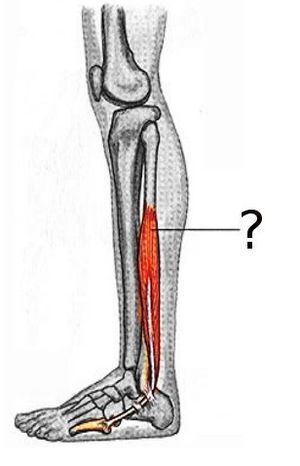Peroneus Brevis
Original Editor -
Top Contributors - Lilian Ashraf, Beverly Klinger, Kim Jackson, Oyemi Sillo and Abbey Wright
Description[edit | edit source]
The Peroneus Brevis (also known as Fibularis Brevis) is a short muscle that lies at the lateral part of the lower leg deep to the Peroneus Longus.[1] It is one of the three peroneus muscles (Pernoeus Longus, Peroneus Brevis and Peroneus Tertius).[2] The Peroneus Brevis along with the Peroneus Longus are commonly injured during a lateral ankle sprain and the tendon of the Peroneus Brevis muscle is the most commonly dislocated tendon.[1]
Origin[edit | edit source]
The Peroneus Brevis originates from the distal two-thirds of lateral fibula.[1] It's tendon passes downwards and loops posterior to the lateral malleolus.[2]
Insertion[edit | edit source]
The Peroneus Brevis inserts on the styloid process at the proximal end of the fifth metatarsal.[1][2]
Nerve[edit | edit source]
The Peroneus Brevis is innervated by the Superficial Peroneal nerve (L5-S2).[1]
Artery[edit | edit source]
The Peroneus Brevis receives its arterial supply from the muscular branches of the peroneal artery.[1]
Function[edit | edit source]
The Peroneus Brevis is responsible for 63% of the power needed to evert the foot as well as assists in plantar flexion along with the Peroneus Longus.[2][3] The peroneii muscle work together to provide dynamic lateral ankle stability during sudden ankle inversion stress.[3]
Clinical relevance[edit | edit source]
Ankle and foot injuries are commonly seen in physiotherapy with a high prevalence of those injuries occuring at the lateral ankle. The most common injuries seen with the Peroneus Brevis is to the tendon by way of tendinopathy, dislocation/subluxation, sprain or splitting.[1] Tendinous injuries to the Peroneus Brevis are usually caused by inversion or supination forces. With a lateral ankle sprain, it is possible that the Peroneus Brevis can tear and cause swelling at the lateral ankle.[1] During a Supination-Adduction injury, the Peroneus Brevis tendon could be injured and could possible pull at the base of the 5th Metatarsal causing an avulsion fracture known as a Jones Fracture.[1]
Assessment[edit | edit source]
Peroneus longus and brevis tests
Treatment[edit | edit source]
References[edit | edit source]
- ↑ 1.0 1.1 1.2 1.3 1.4 1.5 1.6 1.7 1.8 Basit H, Eovaldi BJ, Siccardi MA. Anatomy, Bony Pelvis and Lower Limb, Foot Peroneus Brevis Muscle. InStatPearls [Internet] 2019 May 19. StatPearls Publishing.
- ↑ 2.0 2.1 2.2 2.3 Lippert, Lynn S. Clinical Kinesiology and Anatomy. 5th ed. Philadelphia: F A Davis Company; 2016.
- ↑ 3.0 3.1 Davda K, Malhotra K, O’Donnell P, Singh D, Cullen N. Peroneal tendon disorders. EFORT open reviews. 2017 Jun;2(6):281-92.
- ↑ Endurance Physio. Ankle Eversion (fibularis longus/brevis) Exercise. Available from:https://www.youtube.com/watch?v=JHyEHEwgc6A&feature=youtu.be [last accessed 13/02/2020]







